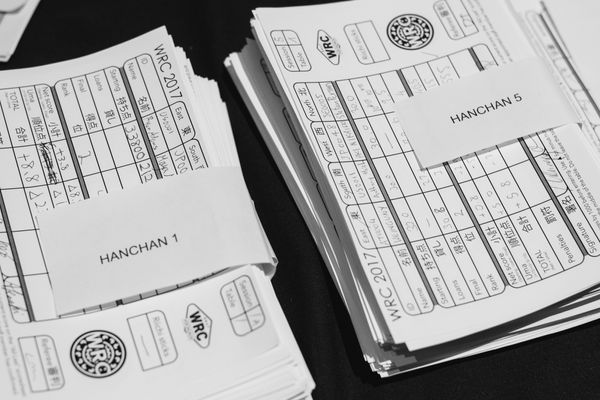Tournament rulesets must be simple
This article of mine was well-received on #osamuko this afternoon. As recommended by osamu, I’ll cross-post it here. :-)
Why game rulesets for tournament play must be simple
This post was inspired by a discussion during the EMA RCR rules revision (Japanese mahjong tournament rules). However, you don’t have to play the game to understand this, this is general ruleset design.
Here are reasons why simplicity is an important design goal.
Barrier of entry
The fewer the rules, the easier it will be to convince nonplayers to learn this game. Learning a game takes building a mental image of the entire ruleset. That is work.
Faster, more natural enjoyment
Having grasped and internalized all rules of a game, playing that game feels much better. There is no nagging feeling anymore that some weird corner case might come up to mess with strategic planning.
Simple rules make this nice experience readily accessible. It takes less time to become proficient.
Simple, natural rules are easy to keep in mind, without actively recalling them all the time. Players can fully concentrate on the strategic decisions. These decisions feel much more natural with simple rules, too, without at all getting trivial.
Inexperienced tournament players
We want people to grasp the full ruleset as fast as possible. Inexperienced tournament players are much more frequent than you would believe. Examples (skip these examples if you don’t know the game):
- One player at Edewecht 2014 looked up the value of a 5-han hand.
- Several people look at the yaku sheet to look up han values of individual yaku.
- Several people have to be reminded of the 2 fu for tsumo.
- One player at the ERC 2013 didn’t want to count han themselves, and just displayed the hand.
These players go to tournaments, and they should go to tournaments. The game is too much a niche game to discourage anyone from joining once they can play without screwing up. We must actively work to get the less experienced players ready to join tournaments.
And what’s beneficial for inexperienced players to grasp all rules quickly? Simple rules.
The above-mentioned players aren’t even standing out compared to these (skip these examples if you don’t know the game):
- One player at Edewecht 2014 didn’t know how furiten after riichi works.
- One player at Edewecht 2014 wasn’t sure whether you could ron against an ankan, and asked during the hand.
- One player at the ERC 2013, in a friendly game before the tournament, thought RCR2012 allowed kuitan if you had at least one red five.
So, 5 experiences out of less than 50 encountered opponents. More than 10 percent of the players don’t know all the rules, and they join.
Having many, fast-acting referees
Referees are called when rare things happen. The referees should have the whole rulebook in their head. Willing referees are already scarce. Nobody wants to travel huge distances only to arbitrate a tournament. We want people from everywhere to become well-versed quickly.
Referees should make decisions to various corner cases with confidence without looking up fiddly exceptions in the rules.
Providing a backbone for house rulers
Tournament rulesets are sometimes considered even by people who don’t play according to these rules, because they wish to find out the very basic rulings.
When people want to play by house rules, such rules almost always end up as a superset of the tournament rules. Tournament rules are a strong support against which house rulers can build their own thing.
Following the expected style of tournamet rulesets
The German card game of Skat has an official tournament ruleset, which is almost an intersection of all house rules out there. The game of Doppelkopf, similarly, has a lean tournament ruleset. Brigde already is super simple, you can’t remove any idea from it, except for the scoring scheme. Go is simple; tournament rulesets for Go differ only in arcane corner cases, because it’s not clear how to handle them easiest.
Chess is already a weirdo in this comparison.
A huge part of tournament rulesets are how to handle oddities coming from the simple game rules. In the RCR ruleset design, some exception handling is our task (chombo value, etc.), others are regulations, as Tina described with the replacement player issue. That’s why other games’ tournament rulebooks are large.
When to override simplicity
There is a ton of reasons why you’d scrap simplicity and use the complicated thing. Usually, this is because players expect something to be there because of the game’s history, or because it’s done similarly in similar games.
Simplicity is one design goal, not the only one.
But think long and hard if you want to ignore it. Laziness is horrible here.
Quotes from masters in other areas
[Software developers] very regularly get some crazy ideas in their head about why they absolutely must do something in a crazy over-complicated way, and they cling to some silly reason why they can’t just do it the simple obvious way. It takes a 3rd party coming in to rip up the code and take out the stupidity.
— from a cbloom rant, beware of strong language. The guy is an expert programmer, both at low level and user interfaces.
By this point in time, we’d all had a lot more experience with game design, and we’d become highly sensitive to little fiddly exceptions in our rules. Our policy was to eliminate them whenever possible.”
— from Kory Heath’s history of designing the game Zendo
Subtractive design is not all rainbows and puppies though. By fully committing to this idea, you are more likely to encounter resistance on your game development team, with your publisher, and with your players. The reason is that when we use vague language, it’s easier to get an agreement. When we use very honest, precise language, it’s easier for someone to realize that they disagreed all along.
[…] Getting rid of all that stuff means there are fewer things for the player to misunderstand, and makes it more likely that the vision of the game in your head actually ends up in the player’s head, too. It takes some courage and pain to commit to a specific idea and subtract the rest away, but I think Ico, Braid, Portal, Team Fortress 2, Google Chrome, and Apple’s Time Machine all demonstrate that doing so can lead to powerful, memorable experiences.
— from David Sirlin, Subtractive Design, the guy is a strong player at beat-’em-ups and has designed several video games.
The very first question you must answer is this: what is your core? What is the game really about? What’s the central idea? Where’s the BEEF?
[…] If your core is actually across two things because you’re brilliantly combining two disparate elements, you don’t have a core. The earth has one core, an apple has one core, a core is a core because it’s one thing. Your core, what your game is all about, should be one thing.
[…] Plus, a design with too many elements is like a dish with too many ingredients; it becomes harder to balance with each additional feature and often comes out as either overwhelming to the palette, obnoxiously over-ambitious, or spread too thin.
— from Jeff Tunnell, How to focus your game and give players more of what they want, again strongly biased towards video game



